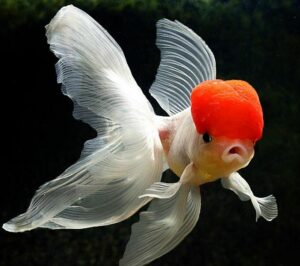Background of Oranda Goldfish
When you hear the term “goldfish,” the image that likely dances across your mind is one of a simple, small fish swimming lazily in a glass bowl. But what if we told you that there exists a type of goldfish that not only shatters this mundane stereotype but also transforms the act of fish-keeping into an art form? Enter the Oranda goldfish—a mesmerizing blend of elegance and personality, clothed in vivid colors and crowned with a distinctive head growth known as the “wen.” Keeping Oranda goldfish is not just a hobby; it’s an exploration into an intricate aquatic world that can bring immense joy, along with a sprinkle of challenges, to your everyday life. As we dive into the specifics, prepare to unravel how these fascinating creatures can captivate your mind and embellish your living spaces in ways you never thought possible.
Why should you care about Oranda goldfish, you may ask? In a world teeming with chaos and constant hustle, we often seek solace and a sense of tranquility. Oranda goldfish offer just that. They aren’t merely pets—they’re living works of art that bring an atmosphere of calm and fascination into any home. Furthermore, engaging with these aquatic wonders can be a deeply rewarding experience, sharpening your skills in responsibility, patience, and mindfulness. Understanding the nuances of their care provides an enriching narrative on how dedicated attention to detail can result in a thriving, beautiful environment that mirrors your commitment and effort.
Breeding and genetics are fundamental cornerstones of both modern agriculture and animal husbandry, as well as various scientific fields like genomics and biotechnology. At its core, breeding involves the deliberate pairing of selected parents to produce offspring with desirable traits, whether those traits are superior yields in crops, heightened resistance to diseases, or specific physical and behavioral characteristics in animals. Over centuries, human intervention has significantly accelerated the natural process of selective breeding, enabling the creation of specialized breeds and strains that optimize productivity, sustainability, and adaptability to diverse environments.
Advancements in genetic science have profoundly amplified the efficacy of breeding programs. With the advent of DNA sequencing and gene-editing technologies such as CRISPR-Cas9, breeders can now identify and manipulate specific genes responsible for desired traits with unprecedented precision. Marker-assisted selection (MAS) and genomic selection are transforming traditional methods by utilizing genetic markers spread across the genome to predict an organism’s performance even before specific traits are expressed. These techniques not only enhance the efficiency and accuracy of breeding efforts but also open new possibilities for addressing challenges such as climate change, food security, and the emergence of new pests and diseases. By integrating classical breeding practices with cutting-edge genetic technologies, researchers and breeders are pioneering the development of resilient and high-performing organisms that can better meet the planetary demands of the 21st century.The Future of Animal Husbandry: A Comprehensive Analysis of ORANDA BREEDING

Oranda Goldfish in Popular Culture
When you hear the term “goldfish,” the image that likely dances across your mind is one of a simple, small fish swimming lazily in a glass bowl. But what if we told you that there exists a type of goldfish that not only shatters this mundane stereotype but also transforms the act of fish-keeping into an art form? Enter the Oranda goldfish—a mesmerizing blend of elegance and personality, clothed in vivid colors and crowned with a distinctive head growth known as the “wen.” Keeping goldfish is not just a hobby; it’s an exploration into an intricate aquatic world that can bring immense joy, along with a sprinkle of challenges, to your everyday life. As we dive into the specifics, prepare to unravel how these fascinating creatures can captivate your mind and embellish your living spaces in ways you never thought possible.
Why should you care about Oranda goldfish, you may ask? In a world teeming with chaos and constant hustle, we often seek solace and a sense of tranquility. Oranda goldfish offer just that. They aren’t merely pets—they’re living works of art that bring an atmosphere of calm and fascination into any home. Furthermore, engaging with these aquatic wonders can be a deeply rewarding experience, sharpening your skills in responsibility, patience, and mindfulness. Understanding the nuances of their care provides an enriching narrative on how dedicated attention to detail can result in a thriving, beautiful environment that mirrors your commitment and effort.
Beyond the realms of relaxation and personal growth, Oranda goldfish also serve as a delightful conversation starter. Imagine friends and family visiting your home, only to be entranced by an intricately designed aquarium boasting these remarkable creatures. Suddenly, your living room turns into an informal gallery, with you as the curator. Here lies an opportunity to educate, share stories, and spread the joy of keeping Oranda goldfish. It’s a subtle way to promote the elegance of this unique breed and foster a deeper appreciation for the wonders of aquatic life.
As we delve further into the practicalities, from setting up the perfect aquarium to ensuring optimal health and diet, you’ll come to see these enchanting fish in an entirely new light. This blog post will guide you through the exhilarating journey of becoming an Oranda goldfish keeper—a journey that promises not just a visual feast but an avenue to cultivate peace, responsibility, and a bit of awe-inspiring artistry in your daily routine. Get ready to immerse yourself in the captivating universe of Oranda goldfish; we promise it’ll be an adventure worth every minute of your time.
